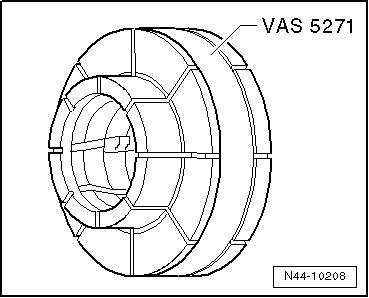| t
| For attaching the wheel, use, for example, the Centering
system for wheel balancing machines -VAS 5271-. |
| t
| This way, it is assured a central positioning of the wheel
at 100% and a very good attachment |
| t
| It is not possible to position the wheel at 100% to the balancing
machine with conical fixtures. |
| t
| A deviation of 0.1 mm outer of the center causes a misbalance
at the wheel/tyre of 10 grams. |
| Evolution of wheel balancing operation. |
| –
| Turn the wheel at the balancing machine. |
| –
| Check the course of the distinctive curves on the side walls
of the tyre next to the rim flap. |
| –
| Check the design of the tyre tread while the wheel is rolling. |

Note | If there is one-sided wear, due to sudden braking or strong
wear due to abrasion, it is not possible to reach the drive stability
through the wheel balancing. In these cases, the tyre must be replaced. |
| –
| Check the concentricity of the wheel. If the wheel rolls
eccentrically, despite of inexistence of deformation, the cause can
be a radial deviation or an axial deviation. |
| –
| Inspect the wheel for existence of radial and axial deviations → Chapter. |
| –
| If the axial and radial deviation remain within the tolerance
values allowed, perform the balancing of the rim and of the tyre. |

Note | t
| Do not use more than 60 grams of weight for each wheel. |
| t
| If the use of more weight is required, it is possible, occasionally,
to obtain better drive stability through the modification of the positioning
of the tyre in relation to the rim in 1/4 of turn sequentially, until
getting the best result. Correction of deviations in the wheel balancing
through the positioning in relation to the rim. → Chapter |
| t
| The indicator on the balancing machine shall show 0 gram. |
| t
| As an alternative to the deviation in the dynamic balancing
of the wheel, the Wheel balancer -VAS 6202-can be used. |
| –
| Screw the wheel to the vehicle. |
| –
| First, screw the lowest stud of the wheel, not tightening
it much, with approximately 30 Nm. |
| –
| Now, tighten the remaining screws for the wheel similarly
with approximately 30 Nm and on a crisscross pattern. This way, it
is possible the centering of the wheel to the corresponding hub. |
| –
| Put the vehicle on the wheels. |
| –
| Now, tighten the studs of the wheel on a crisscross pattern
with a torque wrench with the tightening torque specified for the
vehicle in question. |
| –
| After balancing the wheel, perform a test drive. |
| If during the test drive the continuation of the drive instability
is perceptible, it may happen due to tolerances existing in the centering
of the wheel. |
|
|

|
 Note
Note Note
Note
 Note
Note Note
Note